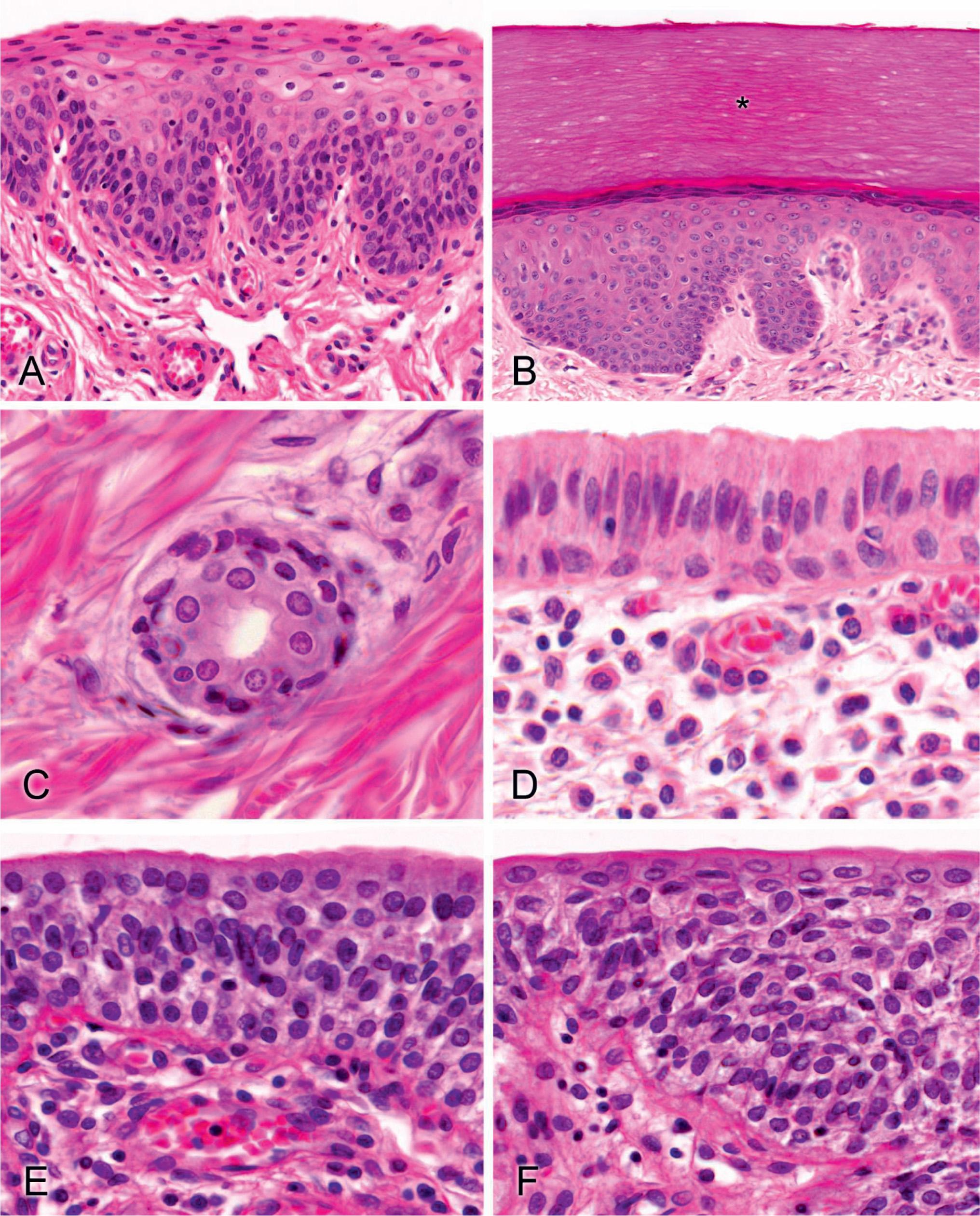Physical Address
304 North Cardinal St.
Dorchester Center, MA 02124
Functionally, epithelium can be subdivided into two main types: covering (surface) epithelium and glandular epithelium. Surface epithelium covers mucous and serous membranes of tubular (hollow) organs as well as the outer surface of the body as epidermis. Structurally, surface epithelium can be composed of a single layer of epithelial cells (simple epithelium) or multiple layers of cells (stratified epithelium). Epithelial cells forming the simple epithelium can be squamous, with flattened nuclei, cuboidal with round-shaped centrally located nuclei and columnar with cylindrical nuclei. These cells form the top layer of stratified epithelia as well; consequently, they define the stratified squamous, stratified cuboidal and stratified columnar epithelia, while the underlying layers are usually composed of cuboidal (polygonal) cells. Stratified squamous epithelia can be keratinized, when the surface cells lose their nuclei and they become filled with keratin; in some cases, the keratinized layer (stratum corneum) retains some of the nuclei resulting in parakeratinized epithelium. The flattened superficial cells of the stratified squamous nonkeratinized epithelium do not show signs of keratinization. A special type of the stratified epithelia is the transitional epithelium or urothelium, due to its location in the urinary system; here, a single layer of large umbrella cells covers the surface. The appearance of the umbrella cells depends on the filling of the urinary tract; when the mucous membrane is stretched, these cells appear to be more flattened while the relaxed mucous membrane tends to form folds with barrel-shaped umbrella cells. Umbrella cells have round-shaped or slightly oval nuclei, cells with two nuclei are common. A specialized form of simple epithelia is the pseudostratified epithelium that is composed of columnar cells that all rest on the basement membrane; however, in contrast of the simple columnar epithelium, their nuclei are not aligned at the same level. The luminal surface of the columnar cells in simple, stratified, and pseudostratified epithelia is often covered by microvilli or cilia.
Glandular epithelia can be functionally categorized as endocrine glands and exocrine glands; the secretion is the former drains into the blood stream while the secretory product of the latter drains on the surface of the mucous membrane. Multicellular exocrine glands can be classified as tubular or alveolar (acinar) glands according to the shape of the base of the gland; they can also be simple (unbranched) or compound glands with branched ducts. The most common form of secretion of exocrine glands is the merocrine (eccrine) secretion when the cell does not lose substantial amounts of cytoplasm during the secretion; vesicles in the cytoplasm fuse with the luminal surface of the cells and empty their content there (exocytosis). Merocrine secretion is characteristic to the salivary glands, where the basal sac of the gland (acinus) forms serous (dark cells with central rounded nuclei) or mucous acini (light cells with more flattened, peripheral nuclei). Occasionally, a serous cap can be observed on the surface of the mucous acinus that represents mixed, seromucous acini with both serous and mucous cells. These serous demilunes are composed of serous cells that are squeezed from between the mucous ones that swell during the histological procedure. Goblet cells are mucous, typically unicellular glands that appear in columnar epithelia. The distended apical portion of these cells contains mucus and it is lined with short microvilli while the thinner basal part contains the nucleus. In contrast to the merocrine secretion, in apocrine secretion the entire apex of the columnar cell, filled with the secretory product, is discharged, and therefore, the shape of the secretory cell varies between columnar and cuboidal. This type of secretion is characteristic for the lactating mammary gland; apocrine sweat glands exhibit the characteristic features of apocrine secretion, but consecutive studies revealed that they secrete with merocrine mechanism. Finally, during holocrine secretion the entire secretory cell dies forming the secretory product itself; this type of secretion can be observed in sebaceous glands.



Muscle tissue is capable of contraction. Skeletal muscle is composed of multinucleated muscle fibers that can be as long as the muscle itself and contain flattened nuclei under the sarcolemma (plasma membrane). The muscle fiber contains contractile myofibrils that exhibit dark A (anisotropic) and light I (isotropic) bands forming a cross striation along the muscle fiber. A thin connective tissue envelope called endomysium surrounds individual muscle fibers, while a thicker perimysium envelopes fiber bundles and the entire muscle is ensheathed by dense connective tissue epimysium. Muscle fibers in the skeletal muscle are innervated by nerve fibers that form motor end plates or neuromuscular junctions on the sarcolemma that operate with cholinergic neurotransmission.
Cardiac muscle forms the myocardium of the heart, and it is composed of branching cardiac muscle cells that form a complex network. The boundaries between the cells appear as intercalated discs. Cardiac muscle cells exhibit delicate cross striation and contain an axially located round-shaped or slightly oval nucleus; occasionally cells may contain two nuclei. Cardiac muscle is very vascular, with a rich capillary network between the cells.
Smooth muscle is composed of spindle-shaped cells that are densely packed against each other. Nuclei are spindle-shaped and pointy and they are located at the axis of the cells; consequently, the transverse section of the cells contains round-shaped cross sections of the nuclei. Smooth muscle is located mainly in the wall of the tubular organs in the gastrointestinal tract and in the urinary and respiratory systems as well as in the wall of vessels.
Myoepithelial cells are branching contractile elements that typically surround the base of the exocrine glands above the basement membrane of the secretory cells and facilitate the release of the secretory product. They contain elongated nuclei as well as cytokeratin filaments.
Become a Clinical Tree membership for Full access and enjoy Unlimited articles
If you are a member. Log in here